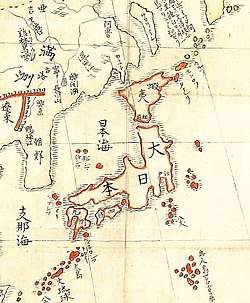Kanpyō (era)
Kanpyō (寛平, Kanpyō, Kanbyō, Kanpei, Kanbei), also romanized as Kampyō was a Japanese era name (年号, nengō, "year name") after Ninna and before Shōtai. This period spanned the years from April 889 through April 898.[1] The reigning emperors were Uda-tennō (宇多天皇) and Daigo-tennō (醍醐天皇).[2]
| History of Japan |
|---|
 |
Change of era
- February 4, 889 Kanpyō gannen (寛平元年): The new era name was created to mark an event or series of events. The previous era ended and the new one commenced in Ninna 5, on the 27th day of the 4th month of 889.[3]
Events of the Kanpyō era
- 889 (Kanpyō 1, 10th month): The former-Emperor Yōzei was newly attacked by the mental illness. Yōzei would enter the palace and address courtiers he would meet with the greatest rudeness. He became increasingly furious. He garroted women with the strings of musical instruments and then threw the bodies into a lake. While riding on horseback, he directed his mount to run over people. Sometimes he simply disappeared into the mountains where he chased wild boars and red deer.[4]
- August 4, 897 (Kanpyō 9, 3rd day of the 7th month): In the 10th year of Uda-tennō 's reign (宇多天皇10年), Emperor Uda abdicated; and his eldest son received the succession (senso).[5]
- August 6, 897 (Kanpyō 9, 5th day of the 7th month): Emperor Daigo formally acceded to the throne (sokui).[6]
Notes
- Nussbaum, Louis-Frédéric. (2005). "Kampyō" in Japan Encyclopedia, p. 465, p. 465, at Google Books; n.b., Louis-Frédéric is pseudonym of Louis-Frédéric Nussbaum, see Deutsche Nationalbibliothek Authority File Archived 2012-05-24 at Archive.today.
- Titsingh, Isaac. (1834). Annales des empereurs du japon, pp. 125–129; Brown, Delmer et al. (1979). Gukanshō, pp. 289–290; Varley, H. Paul. (1980). Jinnō Shōtōki, pp. 175–179.
- Brown, p. 290.
- Titsingh, p. 127.
- Tisingh, p. 129; Varley, p. 44; a distinct act of senso is unrecognized prior to Emperor Tenji; and all sovereigns except Jitō, Yōzei, Go-Toba, and Fushimi have senso and sokui in the same year until the reign of Emperor Go-Murakami.
- Brown, p. 291; Varley, p. 44
gollark: Exactly!
gollark: What do you mean "what"?
gollark: What do you mean "mean"?
gollark: What do you mean "died"?
gollark: <@107118134875422720> I did eventually do that, but am annoyed at CSS for needing it.
References
- Brown, Delmer M. and Ichirō Ishida, eds. (1979). Gukanshō: The Future and the Past. Berkeley: University of California Press. ISBN 978-0-520-03460-0; OCLC 251325323
- Nussbaum, Louis-Frédéric and Käthe Roth. (2005). Japan encyclopedia. Cambridge: Harvard University Press. ISBN 978-0-674-01753-5; OCLC 58053128
- Titsingh, Isaac. (1834). Nihon Ōdai Ichiran; ou, Annales des empereurs du Japon. Paris: Royal Asiatic Society, Oriental Translation Fund of Great Britain and Ireland. OCLC 5850691
- Varley, H. Paul. (1980). A Chronicle of Gods and Sovereigns: Jinnō Shōtōki of Kitabatake Chikafusa. New York: Columbia University Press. ISBN 9780231049405; OCLC 6042764
External links
- National Diet Library, "The Japanese Calendar" -- historical overview plus illustrative images from library's collection
| Preceded by Ninna |
Era or nengō Kanpyō 889–898 |
Succeeded by Shōtai |
This article is issued from Wikipedia. The text is licensed under Creative Commons - Attribution - Sharealike. Additional terms may apply for the media files.